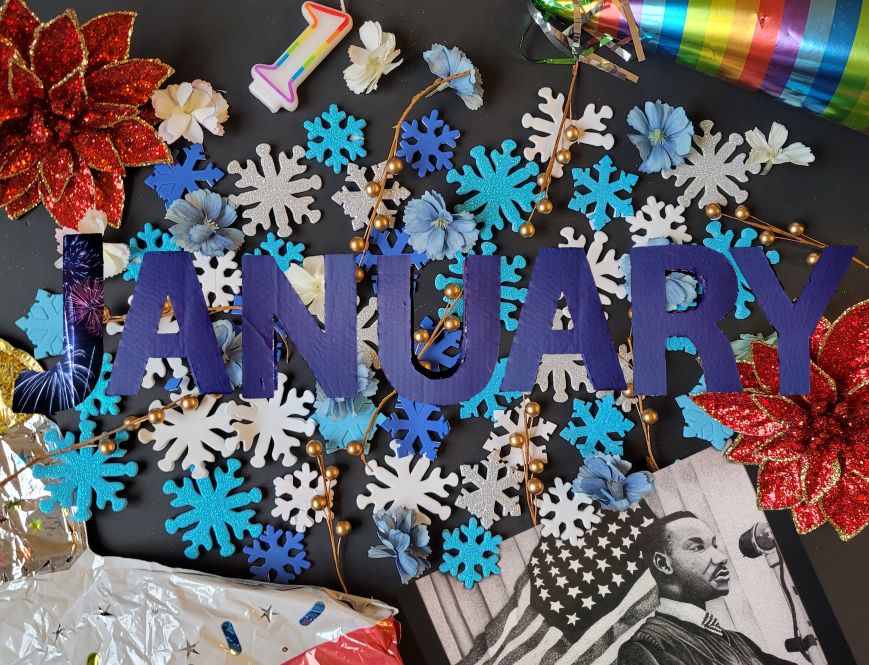The annual BFA Exhibition usually is a gathering of family and friends to view the artistic creations of graduating studio art majors in Art & Art History in an art gallery setting. Works hang on the walls with museum placards, guests enjoy refreshments, and there is a buzz from the conversations throughout the gallery.
During a year with limited in-person classes and activities, including access to art studios, the 2021 exhibition of works by the senior class of 27 students has moved online, along with a 64-page catalog. The exhibition is a mixed media showcase of works in the concentrations within the Art Major: Illustration/Animation, Graphic Design, Painting/Drawing, Photography/Video, Printmaking, and Sculpture/Ceramics.
While working on their projects at home or on campus, and talking remotely with faculty and other students during their critique sessions, seniors were able to experience life after graduation by establishing more complete studio environments with adequate supplies and equipment, according to Alison Paul, associate professor of illustration/animation and one of the four faculty advisors for the exhibition.
“Transitioning from having all the equipment that UConn and the Bishop Center offered them, the illustration/animation concentrators got to have a year of practicing what it would be like once they graduate, especially if they work freelance,” Paul says. “I was impressed with how much the students were able to accomplish under these kinds of extreme circumstances. Usually they’re all in the Bishop Center working, and we’re having impromptu conversations or they’re checking in with me. This year we all only met over Zoom, and yet the quality of illustration and animation work is just as high as it has been in the past. I think it’s a great testament to the students. They all stepped up, stayed focused and produced high quality work. All of the work in the show in all of the concentrations was really, really strong.”
In her artist statement in the catalog, Tash Archibald ’21 (SFA) says she tries “to make my crazy, goofy, childlike imagination come to life.” An illustration/animation concentrator, she designed a calendar themed assemblage based on holidays, seasons and special events with the 12 months of the year. She collected or made objects to represent each month by reusing cardboard boxes, cutting out letters, painting items and sometimes ordering items online. She created for May a representation of Cinco de Mayo with small donkey piñatas and straw hats; party hats, snowflakes and a portrait she drew of Dr. Martin Luther King to illustrate January; for Easter, the ‘A’ in April has bunny ears, among other items, including jellybeans.
“It was very interesting in terms of my creative process,” Archibald says of working remotely while still on campus. “It gave me more time to be more creative and change my ideas. My first idea is drastically different from how my finished product turned out to be. I love being inspired by so many things. I bring that with me and turn to my creative process of being colorful, going outside the boundaries, thinking of things that one usually wouldn’t think of doing.”
Moving the exhibition online and creating a first-time catalog for the senior showcase presented another challenge for students, Paul says. In addition to completing their projects, the students had to document their work and create computer files for use by the Design Center, the award-winning student graphic design studio that is part of the Department of Art & Art History, which created both the exhibition website and catalog. The faculty advisor for the Design Center is Emily Larned, assistant professor of graphic design, whose award-winning handmade publications are collected by more than 70 institutions across the United States and United Kingdom, including the Getty Research Institute, the Brooklyn Museum, and Tate Britain.
“It was really important for students to see what it would be like to work with an art director and a designer and how to get their files ready for publication and for printing,” Paul says. “There were deadlines that were immovable, not the same as the deadlines we have in class. If you missed this deadline, you wouldn’t be in this catalog. There were more real-world consequences. All of that was really great practice for all of the students.”
Other highlights of the 2021 BFA Exhibition include:
• “All of Earth’s History” by Luke Blodgett ’21 (SFA), graphic design, is comprised of stacked discs on a stand showing the physical progression of Earth’s history so they can flip to reveal the spread of landmasses and human civilization.
• “Bittersweet” by Emily Karam ’21 (SFA), graphic design, explores the bitter and sweet perspectives of the $140 billion chocolate industry in a book and digital poster.
• “Found Object Sculpture” by Gordon Markman ’21 (SFA), industrial design, creates musical instruments from found objects.
• “Painting on Hand-Sewn and Collaged Surfaces” by Megan Lauzon ’21 (SFA), painting/drawing, is imagery on pillowcases, sheets, and tarps.
• “BARK” by Sonja Nichols ’21 (SFA), illustration/animation, is a 10-page graphic memoir based on her Labrador retriever, Arwen.
- “Do Ducks Know it’s Monday?” by Miranda Wright ’21 (SFA), illustration/animation, is a book of watercolor illustrations that places animals in unrealistic environments.
-
“Life in Isolation,” Emma Simard ’21 SFA, photography/video, uses her photos to reflect the serious nature of the pandemic time period while the subject matter and their gestures reflect the hope and resilience she witnessed throughout the year.
To view the exhibit and catalog, visit the exhibition website.



